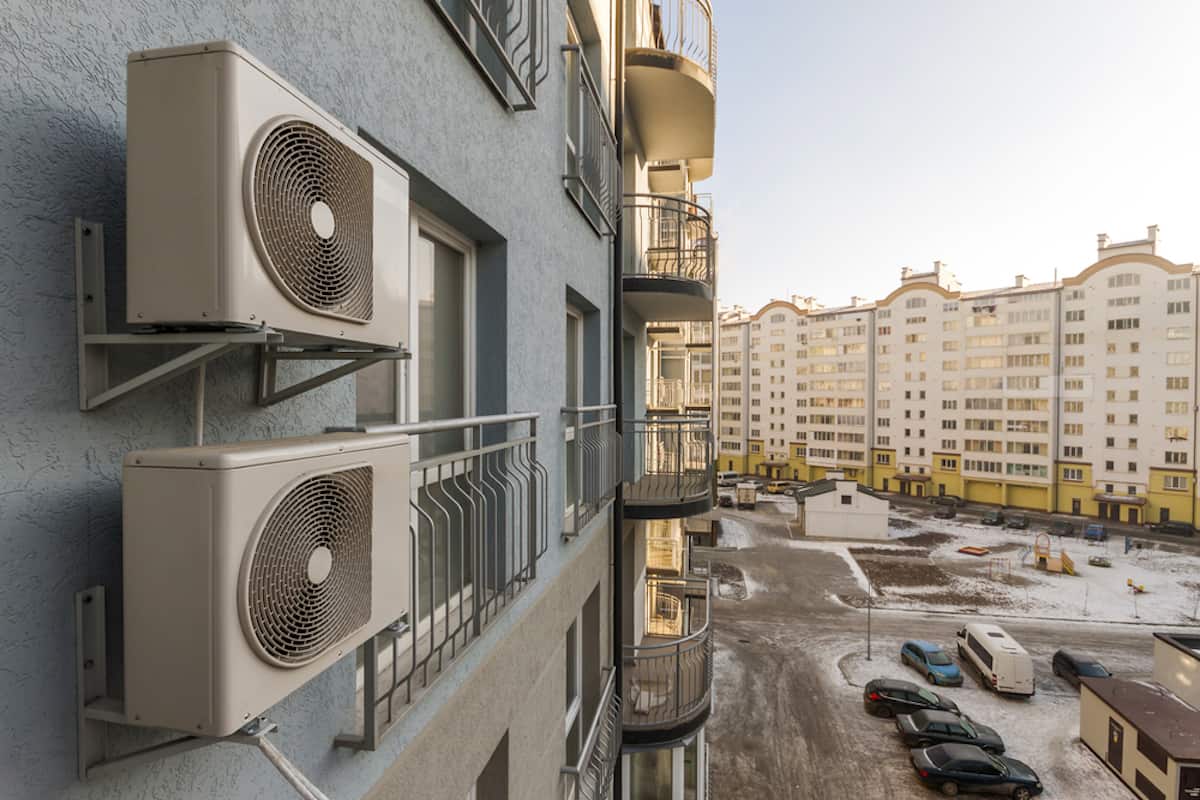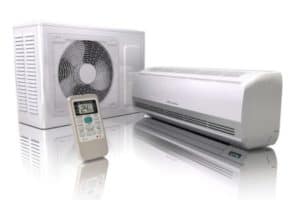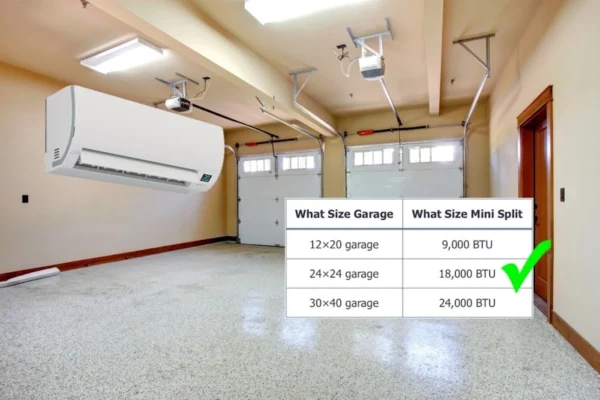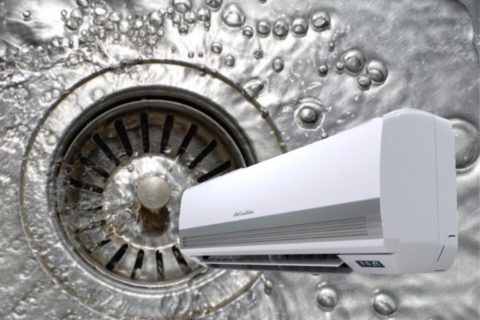Best HVAC System for Apartments (Heating & Cooling)
Many people want to switch from using the centralized HVAC system in their apartment to mini splits for better performance and energy efficiency. But, they wonder if mini splits are good for apartments. So, I did some research.
It turns out that the best HVAC system for apartments is a ductless mini split heat pump system. Mini splits have much higher efficiency than traditional apartment air conditioners and operate more quietly. However, apartments must have a balcony for mini splits to work properly.
Not all apartments are suitable for mini splits. Understanding the different ways to install mini splits in apartments can give you more insights.
Why Mini Splits are Good for Apartments?
Mini splits are decentralized air conditioners while many apartment air conditioners rely on the building’s centralized chillers and boilers for heating and cooling. So, let’s take a closer look at mini splits.
1. Mini Splits are Much Quieter
Traditional apartment air conditioners are noisy because they are supplying a huge amount of airflow through a single air handler.
A typical apartment may have a common source heat pump that uses the chilled water and hot water supplied by centralized chillers and boilers in the building. With such a setup, it is supposed to be quiet because of the absence of the HVAC compressor.
However, an apartment has only one air handler with one return air grille. Hence, the strong airflow causes unpleasant noise to be spread throughout the house.
On the other hand, mini splits are extremely quiet. In fact, mini splits are known for their quiet operation.
A typical 9000 BTU mini split only produces about 20 dB of noise at the indoor unit and about 55 dB of noise at the outdoor unit. Because the outdoor unit is located far away from the room, you hardly can hear any noise coming out of the mini split system.
2. Mini Splits are More Reliable
Apartment air conditioners rely on centralized chillers and boilers that are out of your control in terms of their maintenance and reliability. In other words, if the building management does something wrong with the centralized HVAC system, you’re the one that suffers the consequences.
Besides, the performance of an apartment air conditioner is depending on the water temperature from the centralized HVAC system. Even though you’ve set the temperature low on the thermostat, if the management decided to increase the supply water temperature, you may not have adequate cooling.
In other words, you don’t have complete control over the comfort in your apartment.
Additionally, apartment air conditioners with all the valves and control units are complicated. Hence, if there is a malfunction, the downtime can be longer than acceptable.
Conversely, mini splits are decentralized HVAC systems. You can set the temperature to match your preferences. So, you can always have maximum comfort in your apartment.
Furthermore, if one of your mini split systems malfunctions, it does not affect the other system.
Moreover, the downtime of mini splits is usually lesser than centralized chillers and boilers as mini splits are less complicated and spare parts are widely available.
3. Mini Splits are Efficient
Old apartments may find their electricity cost getting higher every year due to inefficient HVAC systems. Large centralized chillers and boilers are more difficult and costly to maintain.
Hence, their conditions may be worse than expected.
Although centralized HVAC systems are generally more efficient, a lack of proper care and maintenance may cause high-efficient chillers to be less efficient than mini splits.
Among residential air conditioners, mini splits are one of the most efficient HVAC systems. As a matter of fact, mini splits are more efficient than central air conditioners used in single-family homes, window air conditioners and portable air conditioners.
4. Mini Splits Allow Individual Energy Billing
A traditional apartment air conditioner serves the apartment as a whole. If you intended to rent out a room or rent the entire apartment to several tenants, it is very difficult to achieve fair energy billing.
If mini splits were installed in the apartment, each tenant will have their own air conditioning system. An energy meter can be installed at each mini split to monitor the energy usage thereby billing the tenant accordingly and fairly.
What are Mini Splits?
Now that you’ve understood the benefit of mini splits over traditional apartment air conditioners, let’s take a closer look at the mini split itself.
Mini splits are decentralized heating and cooling machines. There are two main categories of mini splits; a) cooling only and b) heating and cooling.
Most mini splits can do both heating and cooling. They are known as mini split heat pumps.
On the other hand, cooling only mini splits are known as mini split air conditioners.
The price of a cooling-only mini split versus a mini split with both heating and cooling functions is negligible. Hence, I’ll refer to mini splits with heating and cooling from here onwards.
Mini splits have two types; a) single-zone and b) multi-zone.
Single-zone mini splits are simpler, cheaper and more efficient. A single-zone mini split has an outdoor unit connected to one indoor unit.
Conversely, a multi-zone mini split has a slightly bigger outdoor unit that is connected to multiple indoor units. Often, a multi-zone mini split outdoor unit can be connected to 2-5 indoor units.
Most of the time, the single-zone mini split makes more sense since it is cheaper and more efficient. However, considering the space limitation of apartments, the multi-zone mini split may be superior in some cases.
The indoor unit of mini splits has 5 different types, namely:
- Wall-Mounted
- Ceiling Cassette
- Ceiling Ducted
- Floor-Mounted
- Ceiling Suspended
The advantages and disadvantages of the 5 different types of mini split indoor units have been covered extensively in my post 5 Types of Mini Split Indoor Units (How to Choose).
In most cases, the wall-mounted type of mini split indoor unit is your best choice. However, it is not uncommon for apartments to use the ceiling cassette type for interior aesthetics.
Most mini splits are powered by 220V. However, there is a handful of mini splits that use 110V which is perfect for most apartments since the standard power outlet voltage in the United States and many other countries is only 110V.
However, for countries like Malaysia and Singapore, the standard power outlet voltage is 230V. Upgrading from 110V to 220V is possible but troublesome, especially for apartments.
So, you are better off with the 110V mini split.
Nonetheless, 110V mini splits are slightly less efficient but slightly cheaper.
For each indoor unit, the following components must be installed:
- Refrigerant Pipes – Transfer energy between the indoor and outdoor unit.
- Drain Pipe – Discharge condensate water.
- Power and Signal Wires – Power supply and indoor/outdoor communications.
Most of the time, the components listed above come with the mini split or the seller will inform you to include them together. So, make sure you’ve budgeted the components as well.
Usually, the maximum distance between the indoor and outdoor unit of a mini split is about 65 ft (20 m) for low capacity models and 100 ft (30 m) for high capacity models. However, the distances are referring to the refrigerant pipes. So, the actual distance between the indoor and outdoor unit is much shorter depending on the arrangement of the refrigerant pipes.
This information can be easily found in the respective mini split specification datasheet.
The location of mini splits is important because it can affect the performance. For a detailed guide, see my post Best Place to Put the Mini Split Air Handler and Condenser.
Because a mini split transfers energy from indoor to outdoor, the outdoor unit of mini splits must be located in an open space such as a balcony, a yard or equivalent. If the mini split outdoor unit is not exposed to the outside air, the system will not work.
However, if your apartment doesn’t have a balcony or equivalent, the outdoor unit can be hung on the external wall given that you obtain all the necessary approvals.
In countries like Malaysia and Singapore, it is very common to see mini split outdoor units hanging on the external wall of apartments and medium-height buildings. For high-rise buildings with more than 20 floors, the outdoor unit usually has a dedicated open space like a yard.
Standard mini splits are unable to perform well when the outdoor temperature falls harshly during the winter. If you’re living in a very cold place, the low ambient heating mini splits must be selected. For more details, see my post 11 Best Mini Splits for Heating (Cold Climate Models).
Most mini splits need a professional for the installation. However, the upfront cost for the installation is often as much as the mini split itself. So, if a mini split cost $1000, the installation cost is also around $1000 depending on location.
By the way, if you want to learn more about mini split especially how to design it for your house, consider my Mini Split (eBook). You’ll learn what is Mini Split, how to choose and more importantly, spark more design ideas to improve the energy efficient of your house. But, if you need a second opinion or want someone to help you design, then you can consider my consultation service.
Consultation Service
Ask me for HVAC advice such as brand selection, best model, benefits, features, placement, duct size, grille size, how to design, design check, verification and other HVAC related queries.
How to Install a Mini Split System in Apartments?
There are a few ways to install a mini split system in apartments depending on the apartment unit floor plan. Mini splits don’t always need to be installed on exterior walls. They can be placed on the interior floor as well given that there is adequate ventilation for heat transfer.
Now, let’s look at a few common apartment types and compare the respective mini split system.
Studio Apartment (600 sqft)
Studio apartments are the economic type of apartment. This type of apartment unit usually has about 600 sqft of floor area. So, low cost is the priority.
Below is an example of a mini split system in a 600 sqft studio apartment:
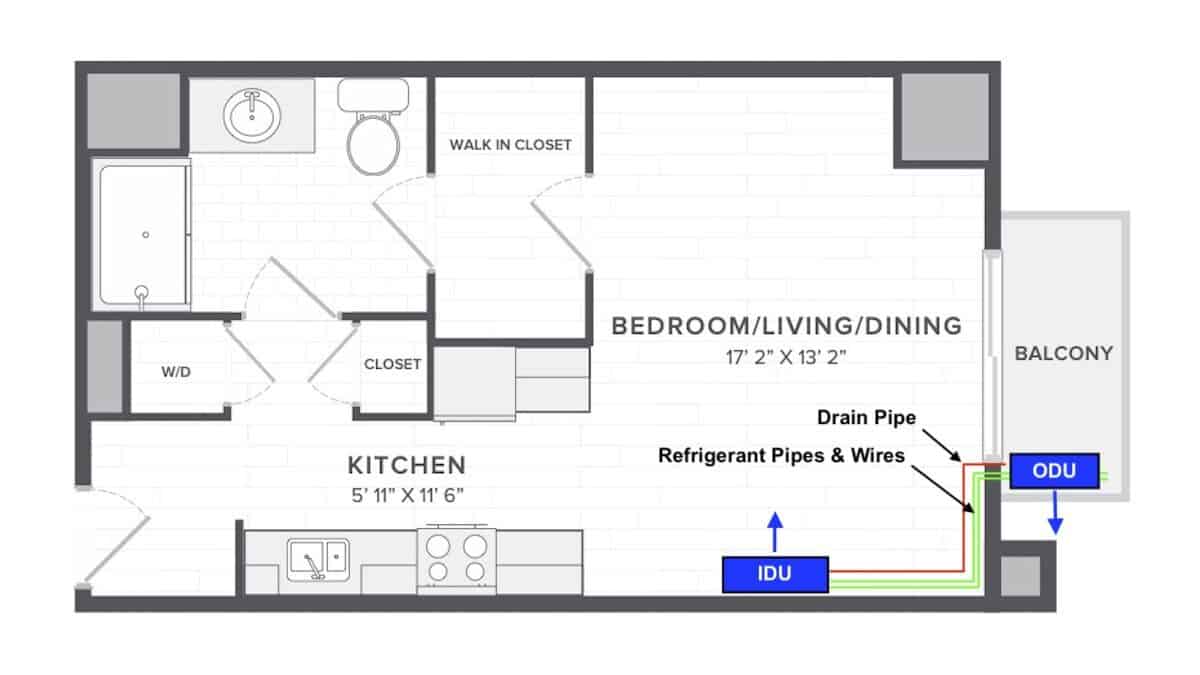
From the above layout drawing, a single-zone mini split is recommended. Since the living space is only about 300 sqft, a 9000 BTU model will be sufficient.
If your apartment has no ceiling, the refrigerant pipes, wires and drain pipe most likely need to run on the surface of the wall. However, they can be covered by PVC trunking for better aesthetics.
Running the pipes and wires in the wall is possible. In fact, it is very common in countries like Malaysia and Singapore. For more details, see my post Can You Run Mini Split Refrigerant Lines in Walls?.
The condensate water can be discharged at the balcony since there is a floor trap at the balcony. However, it is recommended that you don’t tap the drain pipe into the rainwater downpipe because it may cause a backflow during heavy rain.
The indoor unit (IDU)can be directly mounted on the wall. As for the outdoor unit (ODU), you can place it directly on the floor but with dedicated rubber mounts to prevent rattling noise.
For a 600 sqft studio apartment, the following mini splits are recommended:
1 Bedroom 1 Bathroom Apartment (800 sqft)
The 1 bedroom 1 bathroom (1B1B) apartment is a very common type of apartment. This type of apartment usually has a floor area of around 800 sqft.
For an 800 sqft apartment, the single-zone mini split is still preferred for simplicity and low cost.
Below is an example of a mini split system in an 800 sqft 1B1B apartment:
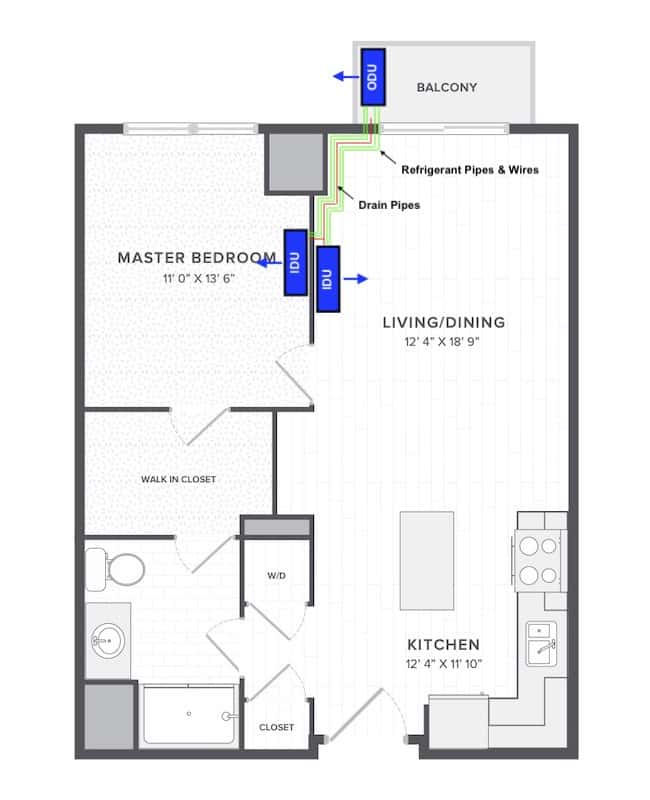
A 9000 BTU single-zone mini split and a 12000 BTU single-zone mini split are adequate for the bedroom and the living room respectively. For mini split capacity sizing, see my post Mini Split Sizing Guide: How-to, Chart & Example.
Notice that the drain pipe from two separate indoor units is joined together with a slightly bigger drain pipe. Typically, the drain pipe size of a mini split is 3/4″ (20mm). So, the main drain pipe should be one size bigger which is 1″ (25mm).
The indoor units are installed as close to the outdoor units as possible to minimize the pipes and wires length as well as improve the aesthetics. However, try not to put the mini split in a corner as it’ll cause the other end of the room not to have sufficient heating/cooling.
Since it is a single-zone mini split, having two indoor units mean that there are two outdoor units as well.
For the outdoor units, you can stack them up using a floor mounting bracket. However, such a bracket may not be easily found online. Otherwise, you can sacrifice some floor area and put both outdoor units directly on the floor.
In addition, if your balcony has sufficient wall space, you can mount both outdoor units (up and down) on the wall using wall brackets that are commonly sold on Amazon or other platforms.
Below is a photo showing four mini splits stacked tightly on top of each other:
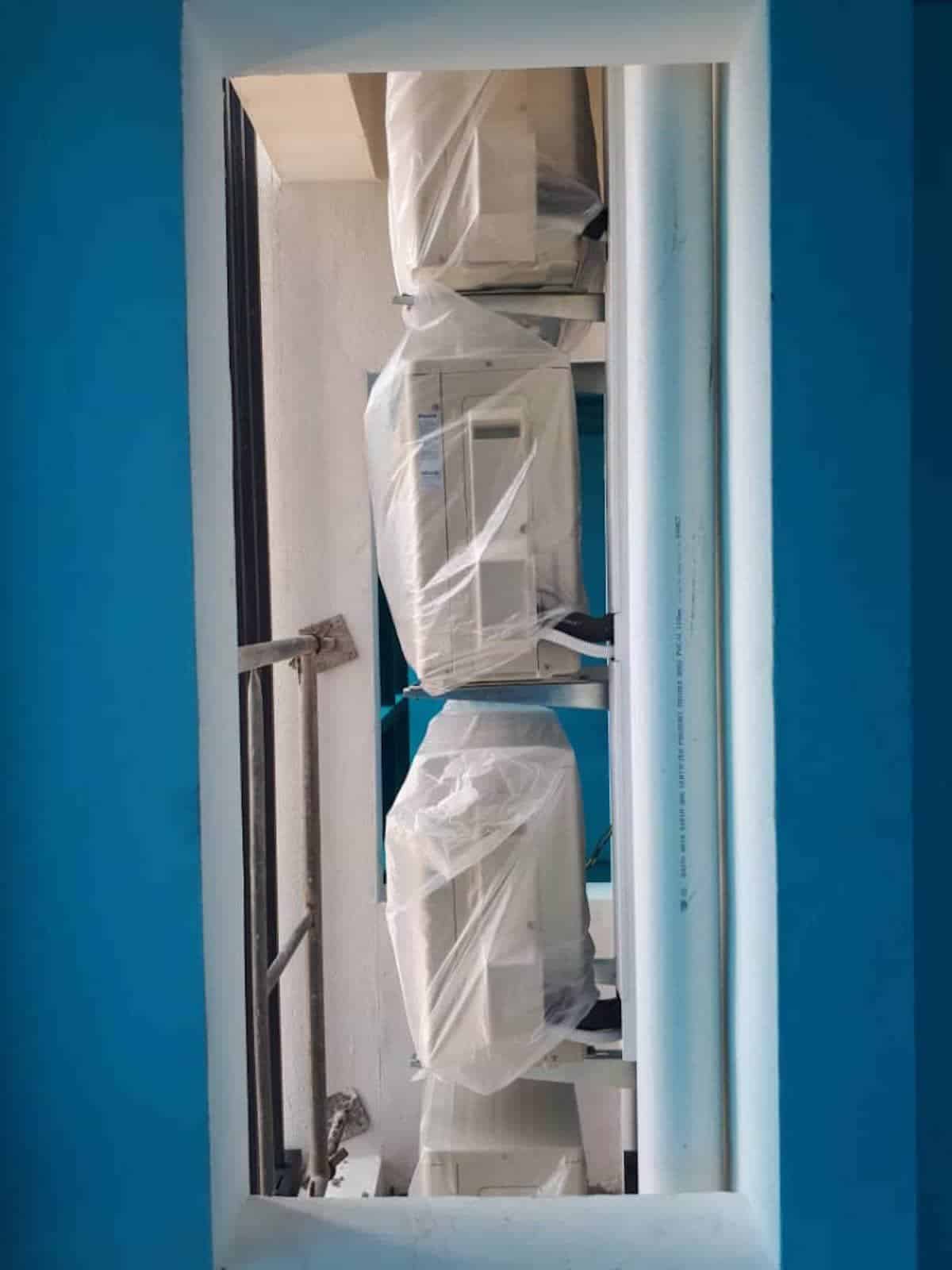
For an 800 sqft 1B1B apartment, the following mini splits are recommended:
- Gree Livo+ 115V Ductless Mini Split Heat Pump (View on Amazon)
- Daikin 19 Series 230V Ductless Mini Split Heat Pump (View on Amazon)
2 Bedrooms 2 Bathrooms Apartment (1200 sqft)
Medium-sized apartments often have 2 bedrooms and 2 bathrooms (2B2B). This type of apartment has about 1200 sqft of floor area.
Since there are more rooms, if the single-zone mini split is deployed, there will be 3 outdoor units and the apartment may not have sufficient space for outdoor units.
Hence, the multi-zone mini split system is preferred.
Below is an example of a mini split system in a 1200 sqft 2B2B apartment:
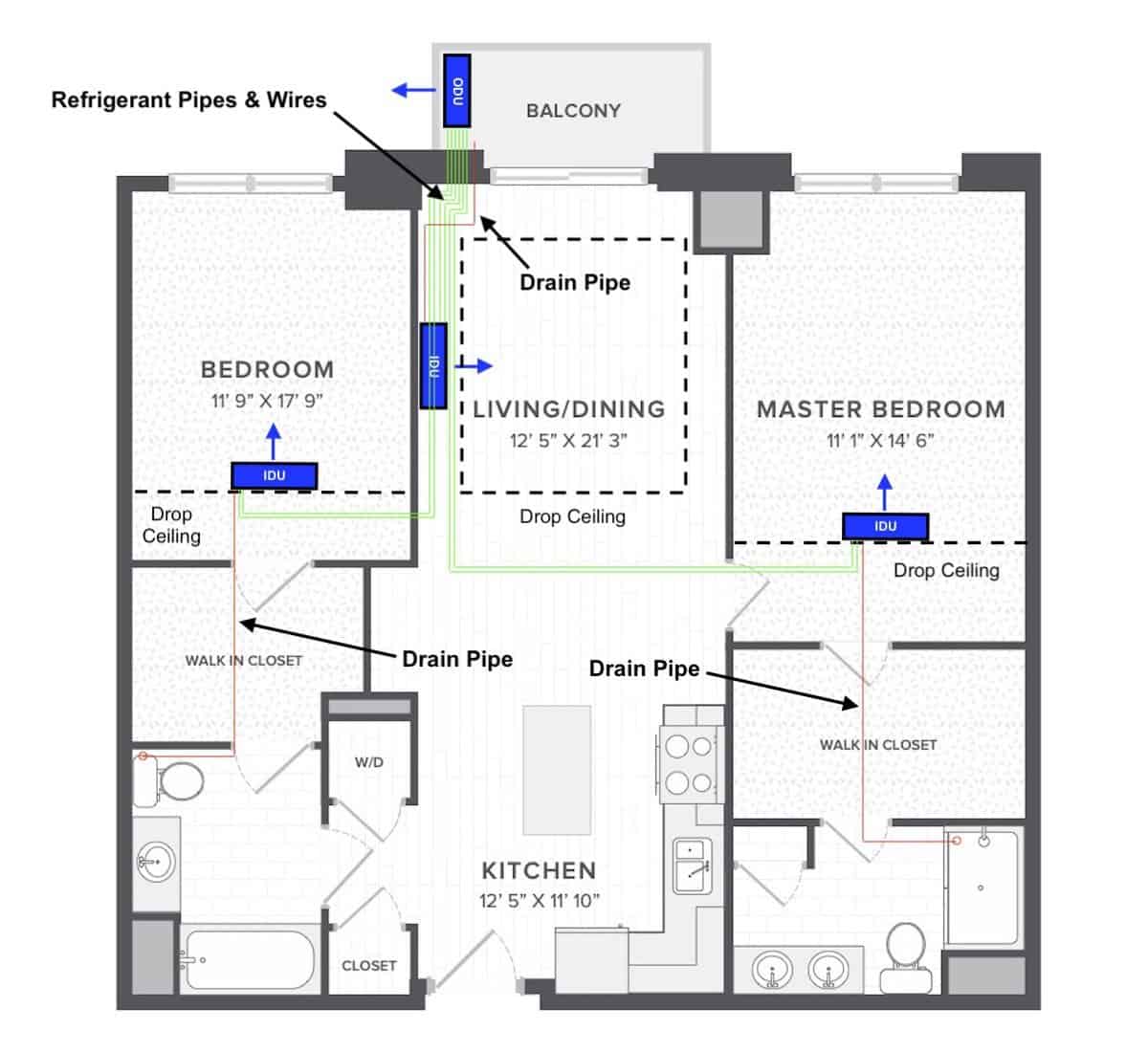
The mini split size for the above apartment is as follow:
- Bedroom: 9000 BTU
- Living Room: 12000 BTU
- Master Bedroom: 9000 BTU
A 1200 sqft apartment usually has a ceiling in the living room and the bedroom. Hence, the mini split indoor unit can be mounted on the drop ceiling in the bedroom as shown above.

The pipes and wires can run freely above the ceiling with the ceiling, supported by slab anchors, rods and brackets.
However, suppose the indoor unit is not able to be mounted on the drop ceiling (for example, in the living room). In that case, the pipes and wires can run vertically towards the ceiling with a short length exposed on the surface of the wall which can be covered by a PVC trunking as well.
Otherwise, you also can hide a short vertical length of pipes and wires inside the wall before running them above the ceiling as shown below:

Compared to the single-zone mini split, the size of the multi-zone mini split outdoor unit is taller; almost double the height of the single-zone one.
Since it is bulkier and heavier, the outdoor unit is usually placed on the floor with a dedicated ground mount bracket as well as rubber pads.
Multi-zone mini splits are slightly more complex. Hence, it is advisable that you consult your local HVAC company. However, a few multi-zone mini split brands worth mentioning are:
- Mitsubishi
- Daikin
- Fujitsu
3 Bedrooms 3 Bathrooms Apartment (1500 sqft)
3 bedrooms 3 bathrooms (3B3B) apartments are considered luxury apartments. This type of apartment typically has 1500 sqft of floor area or more.
Similarly, a multi-zone mini split system is more suitable for such a large apartment size. However, to align with the luxury experience, the ceiling cassette type of indoor unit can be deployed.
Below is an example of a mini split system in a 1500 sqft 3B3B apartment:
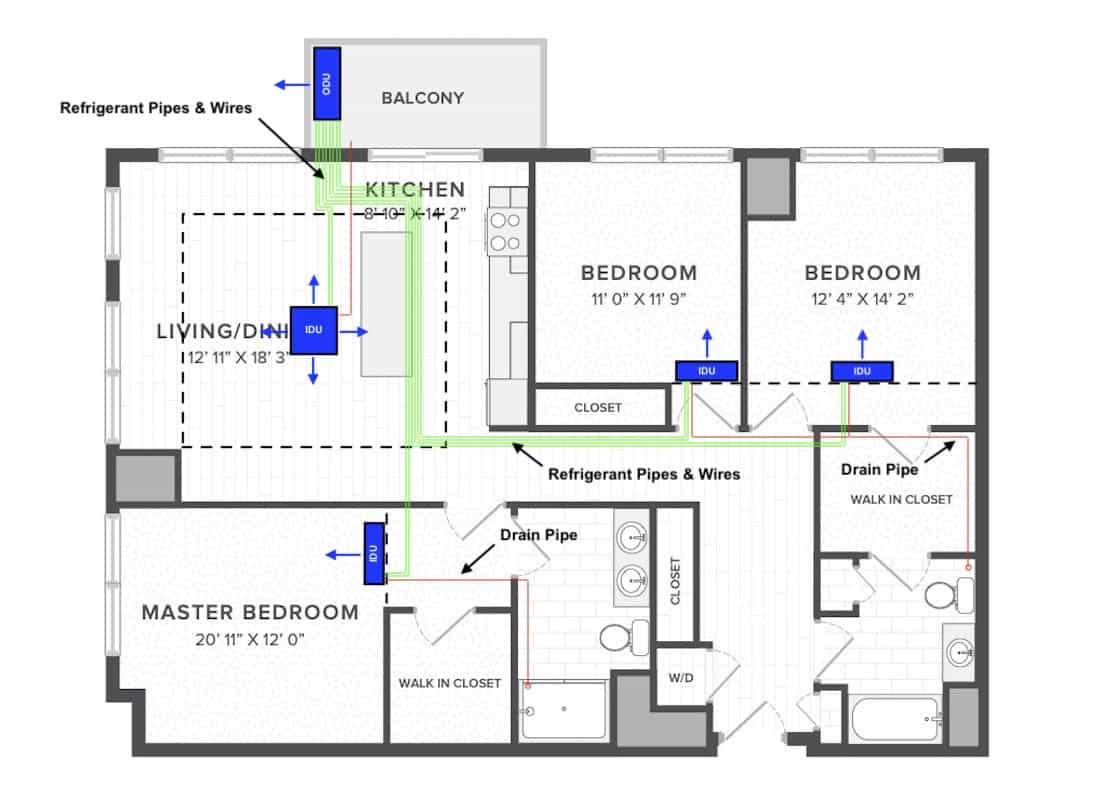
The corresponding mini split capacity is as follow:
| Apartment Room | Mini Split Size |
|---|---|
| Living + Kitchen | 12,000 BTU |
| Master Bedroom | 9,000 BTU |
| Bedroom 2 | 9,000 BTU |
| Bedroom 3 | 9,000 BTU |
At a glance, the biggest difference is the indoor unit for the living room. A ceiling cassette mini split is chosen for the living room for better aesthetics and air distribution.
Ceiling cassette units are suitable for square-shaped rooms.
For the rest of the room, the mini split design is similar to the 1200 sqft 2B2B apartment. However, as the mini split total capacity increases, the physical dimension of the multi-zone outdoor unit also increases.
So, more space is needed for such a mini split system.
On a side note, multi-zone mini splits are usually less efficient and more expensive in total when compared to single-zone mini splits.
If you have the necessary approvals and you don’t mind the external appearance of your apartment, the following mini split placement strategy (warning: extreme cases) may be considered:


Needless to say, hardly anyone will recommend either installation method as shown above. Nonetheless, it is one of the options if you really don’t have any space inside the apartment.
Such a mini split placement is not uncommon. In fact, many countries including Malaysia are having this kind of mini split installation, especially in low-cost apartments because valuable floor area for mini split outdoor units is excluded in an effort to improve home affordability.
Final Thought
Mini splits are excellent for apartments. In Malaysia, we’ve been using mini splits in apartments for as long as I remember. For apartments that use a centralized heating and cooling system, the biggest challenge about switching to a mini split system is the necessary approvals and a dedicated open area for the mini split outdoor unit.
If your apartment doesn’t have any open space and hanging the outdoor unit on the exterior wall is not feasible, then mini splits are not suitable for you. Otherwise, mini splits can provide you with better comfort, a quiet environment and potentially, less energy cost.
Lastly, consider my Mini Split (eBook) if you want to know how can you use Mini Split in your house. If you still have doubt or not feeling confident enough, feel free to consult me.
Consultation Service
Ask me for HVAC advice such as brand selection, best model, benefits, features, placement, duct size, grille size, how to design, design check, verification and other HVAC related queries.
If you have anything to add (or ask) about this topic, leave a comment down below!


